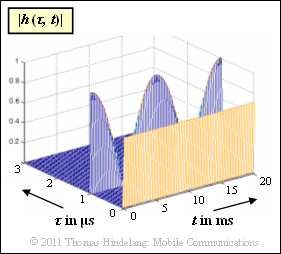Exercise 2.4: 2D Transfer Function
The graph shows the two-dimensional impulse response $h(\tau, \hspace{0.05cm}t)$ of a mobile radio system in magnitude representation.
- It can be seen that the 2D–impulse response only has components at delays $\tau = 0$ and $\tau = 1 \ \rm µ s$ .
- At these times:
$$h(\tau = 0\,{\rm µ s},\hspace{0.05cm}t) \hspace{-0.1cm} \ = \ \hspace{-0.1cm} \frac{1}{ \sqrt{2}} = {\rm const.}$$ $$h(\tau = 1\,{\rm µ s},\hspace{0.05cm}t) \hspace{-0.1cm} \ = \ \hspace{-0.1cm} \cos(2\pi \cdot {t}/{ T_0})\hspace{0.05cm}.$$
For all other values of $\tau$, we have $h(\tau, \hspace{0.05cm}t) \equiv 0$.
We want to obtain the two-dimensional transfer function $H(f, \hspace{0.05cm} t)$ as the Fourier transform of $h(\tau, t)$ with respect to the delay $\tau$:
- $$H(f,\hspace{0.05cm} t) \hspace{0.2cm} \stackrel {f,\hspace{0.05cm}\tau}{\bullet\!\!-\!\!\!-\!\!\!-\!\!\circ} \hspace{0.2cm} h(\tau,\hspace{0.05cm}t) \hspace{0.05cm}.$$
Notes:
- This task belongs to chapter Mehrwegeempfang beim Mobilfunk.
- A similar problem is treated in Task 2.5 but with a different nomenclature.
Questionnaire
Sample solution
{
(2) At the time $t_1 \ \underline {= 5 \ \ \rm ms}$ is $h(\tau = 1 \ {\rm µ s}, t_1) = 0$. Accordingly, the following applies
$$h(\tau = 1\,{\rm µ s},\hspace{0.05cm}t_1) = \frac{1}{ \sqrt{2}} \cdot \delta(\tau)\hspace{0.3cm}\Rightarrow \hspace{0.3cm}
H(f,\hspace{0.05cm}t_1) = \frac{1}{ \sqrt{2}} = {\rm const.}$$
The same applies to $t_2 \ \underline {= 15 \ \ \rm ms}$: $$h(\tau = 1\,{\rm µ s},\hspace{0.05cm}t_2) = \frac{1}{ \sqrt{2}} \cdot \delta(\tau)\hspace{0.3cm}\Rightarrow \hspace{0.3cm} H(f,\hspace{0.05cm}t_2) = \frac{1}{ \sqrt{2}} = {\rm const.}$$
(3) At time $t = 0$ the impulse response with $\tau_1 = 1 \ \ \rm µ s$: $$h(\tau,\hspace{0.05cm}t = 0) = \frac{1}{ \sqrt{2}} \cdot \delta(\tau)+ \delta(\tau - \tau_1)\hspace{0.05cm}.$$
The Fourier transform leads to the result: $$H_0(f) = H(f,\hspace{0.05cm}t = 0) \hspace{-0.1cm}. \ = \ \hspace{-0.1cm} \frac{1}{ \sqrt{2}} + 1 \cdot {\rm e}^{- {\rm j}\cdot 2 \pi f \tau_1}=\frac{1}{ \sqrt{2}} + \cos( 2 \pi f \tau_1)- {\rm j}\cdot \sin( 2 \pi f \tau_1)$$ $$\Rightarrow \hspace{0.3cm} |H_0(f)| \hspace{-0.1cm} \ = \ \hspace{-0.1cm} \sqrt { \left [ {1}/{ \sqrt{2}} + \cos( 2 \pi f \tau_1) \right ]^2 + \left [\sin( 2 \pi f \tau_1)\right ]^2}= \sqrt { 0.5 + 1 + {2}/{ \sqrt{2}} \cdot \cos( 2 \pi f \tau_1)} = \sqrt { 1.5 + { \sqrt{2}} \cdot \cos( 2 \pi f \tau_1)}\hspace{0.05cm}.$ It follows: * $H_0(f)$ is periodic with $1/\tau_1 = 1 \ \rm MHz$. * For the maximum value or minimum value applies: $${\rm Max}\, \left [ \, |H_0(f)|\, \right ] \hspace{-0.1cm} \ = \ \hspace{-0.1cm} \sqrt { 1.5 + { \sqrt{2}} } \approx 1.707 \hspace{0.05cm},\hspace{0.5cm}{\rm Min}\, \left [ \, |H_0(f)|\, \right ] \hspace{-0.1cm} \ = \ \hspace{-0.1cm} \sqrt { 1.5 - { \sqrt{2}} } \approx 0.293 \hspace{0.05cm}. $$ * At $f = 0$, $|H_0(f)|$ has a maximum. Therefore, <u>all three solution suggestions</u> are correct. '''(4)''' For the time $t = 10 \ \rm ms$ the following equations apply: $$h(\tau,\hspace{0.05cm}t = 10\,{\rm ms}) \hspace{-0.1cm} \ = \ \hspace{-0.1cm} \frac{1}{ \sqrt{2} \cdot \delta(\tau)- \delta(\tau - \tau_1)\hspace{0.05cm},$$ $$H_{10}(f) = H(f,\hspace{0.05cm}t = 10\,{\rm ms}) \hspace{-0.1cm} \ = \ \hspace{-0.1cm}
\frac{1}{ \sqrt{2}} - \cos( 2 \pi f \tau_1)+ {\rm j}\cdot \sin( 2 \pi f \tau_1)\hspace{0.05cm},$$
:$$ |H_{10}(f)| \hspace{-0.1cm} \ = \ \hspace{-0.1cm}
\sqrt { 1.5 - { \sqrt{2}} \cdot \cos( 2 \pi f \tau_1)}\hspace{0.05cm}.$
[[File:P_ID2163__Mob_A_2_4d.png|right|frame|2D impulse response $|h(\tau, \hspace{0.05cm}t)|$ and 2D transfer function $|H(f, \hspace{0.05cm}t)|$]]
Correct are the <u>solutions 1 and 2</u>:
*The frequency period does not change from $t = $0.
*The maximum value is still $1,707$ and the minimum value $0,293$ does not change compared to the subtask '''(3)''.
*For $f = 0$ there is now a minimum and no maximum.
The graph on the right shows the amount $|H(f, t)|$ of the 2D–transfer function.
